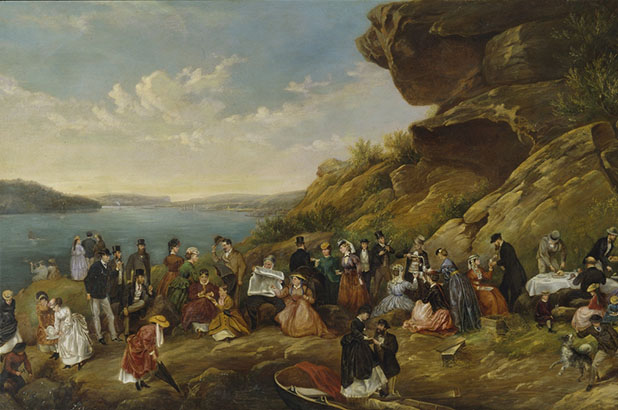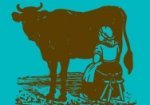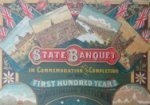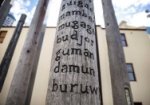While many Sydney-siders gather around the harbour for New Year’s eve celebrations, New Year’s Day was often spent in public celebration in colonial times in the form of a foreshore picnic. Montagu Scott’s extraordinarily detailed depiction of such an event gives a brilliant ‘snapshot’ of revelers and their antics in 1870. The detail is extraordinary, and offers us a fabulous insight into the way people dressed and groomed themselves (as per Scott’s recent Flavour saver post), spent their leisure time, and most importantly to the colonial foodies among us, how they entertained, celebrated and dined, albeit al freso. It even shows the types of glassware and crockery in use in period, and the straw-lined crates that yielded the seemingly copious quantities of champagne.

A day’s picnic on Clark Island, Sydney Harbour (detail), Montagu Scott, 1870. State Library of New South Wales: ML3 .
An elegant affair
Far from the relaxed ideal of a leisurely picnic, this work shows the enormous trouble that some people underwent to eat outdoors, enabled, most probably, by the many servants that would have worked behind the scenes, preparing and packing all the food and accoutrements, and indeed, rowing it all, and the elegantly dressed picnickers themselves, across to Clark Island, located just off Elizabeth Bay and Point Piper. It appears to be a most chivalrous occasion, with the men-folk attentively waiting on the ladies, whether pouring a glass, carving meat, prizing oysters from the rocks or passing plates or fruit.
A full description of the painting, published in the Sydney illustrated in 1870 is quoted at the end of this page, or you can view this magnificent artwork at the Museum of Sydney in the Eat your history: a shared table exhibition (until March 9, 2014).
A picnic for forty persons
If you were thinking of recreating a 19th century picnic spread, Mrs Beeton very usefully provides a menu in her Book of household management (1861). Note the cold plum pudding and that coffee is unsuitable for a picnic, being difficult to make. I’m really not sure what is meant by ‘tin bread (for tea)’ – loaf cakes perhaps?
Bill of fare for a picnic for 40 persons.
2149. A joint of cold roast beef, a joint of cold boiled beef, 2 ribs of lamb, 2 shoulders of lamb, 4 roast fowls, 2 roast ducks, 1 ham, 1 tongue, 2 veal-and-ham pies, 2 pigeon pies, 6 medium-sized lobsters, 1 piece of collared calf’s head, 18 lettuces, 6 baskets of salad, 6 cucumbers.
2150. Stewed fruit well sweetened, and put into glass bottles well corked; 3 or 4 dozen plain pastry biscuits to eat with the stewed fruit, 2 dozen fruit turnovers, 4 dozen cheesecakes, 2 cold cabinet puddings in moulds, 2 blancmanges in moulds, a few jam puffs, 1 large cold plum-pudding (this must be good), a few baskets of fresh fruit, 3 dozen plain biscuits, a piece of cheese, 6 lbs. of butter (this, of course, includes the butter for tea), 4 quartern loaves of household broad, 3 dozen rolls, 6 loaves of tin bread (for tea), 2 plain plum cakes, 2 pound cakes, 2 sponge cakes, a tin of mixed biscuits, 1/2 lb, of tea. Coffee is not suitable for a picnic, being difficult to make.
While some of the menu items above might not pass muster these days – collared calf’s head anyone?, her checklist would still be quite appropriate. Well, ok, perhaps not the sherry and brandy, though they would help make up an exceptional punch…
Things not to be forgotten at a Picnic.
2151. A stick of horseradish, a bottle of mint-sauce well corked, a bottle of salad dressing, a bottle of vinegar, made mustard, pepper, salt, good oil, and pounded sugar. If it can be managed, take a little ice. It is scarcely necessary to say that plates, tumblers, wine-glasses, knives, forks, and spoons, must not be forgotten; as also teacups and saucers, 3 or 4 teapots, some lump sugar, and milk, if this last-named article cannot be obtained in the neighbourhood. Take 3 corkscrews.
2152. Beverages.—3 dozen quart bottles of ale, packed in hampers; ginger-beer, soda-water, and lemonade, of each 2 dozen bottles; 6 bottles of sherry, 6 bottles of claret, champagne discretion, and any other light wine that may be preferred, and 2 bottles of brandy. Water can usually be obtained so it is useless to take it.
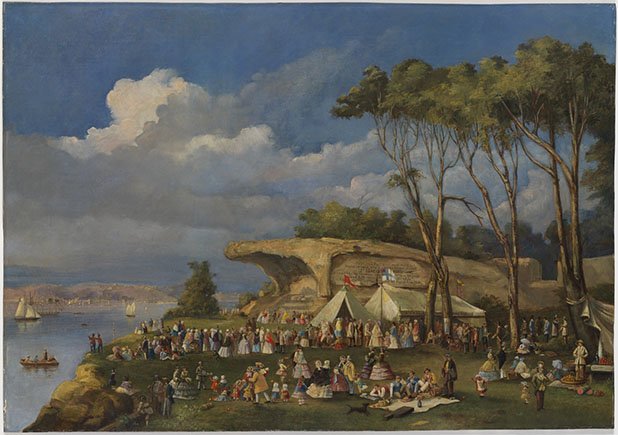
Picnic at Mrs Macquarie’s Chair, artist unknown, circa 1855 State Library of New South Wales: DG 265
The Clark Island scene from 1870 is far more elaborate than the Victorian Christmas day picnic depicted by Frederick Grosse in 1865 and Picnic at Mrs Macquarie’s chair on Regatta Day (January 26) circa 1855 (below). Note the significant change in fashions, the main distinction being the wide crinoline dresses worn in the 1850s. Despite the seemingly formal costuming, the general atmosphere in the earlier picnics portray more relaxed affairs, the food and drink being laid on picnic blankets rather without emphasis on champagne and fine glassware; the little children adding an innocence to the scenes.
Changing tastes
As with the ladies’ fashions, Mrs Beeton’s recommendations also altered over time, with a much smaller selection of sweet options in this 1880s edition: no doubt Australian colonists would have to be somewhat selective in their choices, jellies and blancmanges would not last long in the Antipodean heat!
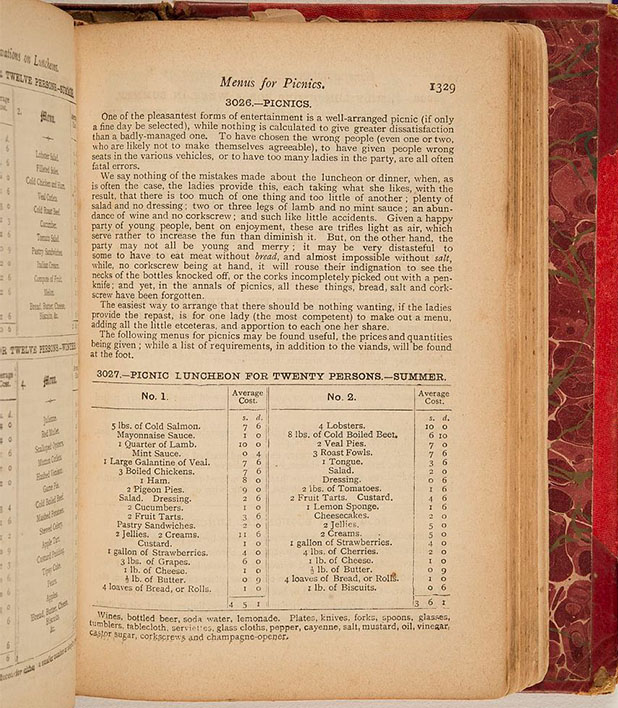
Menu for picnics, Mrs Isabella Beeton, Mrs Beeton’s book of household management, London, circa 1880, page 1329. Rouse Hill House and Farm Collection, Sydney Living Museums
Extract from Sydney Illustrated, September 6, 1870:
Mr Scott’s picture we understand represents a large body of picnicers [sic] who have landed on New Year’s Day on Clark Island … To the left of the picture two or three young ladies are waiting for oysters which one of the party is knocking on a rock, while near at hand some lady of scientific turn of mind is spearing some “wonder of the deep” with her parasol. At the rear a quiet little flirtation is going on by two ladies sheltered beneath the umbrella which also serves to conceal the proceedings from their parents on the right. They have not however escaped the watchful eye of “mamma” who is calling to the attention of “pappa” to the state of affairs. The old gentleman though is not the least happy of the party, cannot leave his business proclivities behind and has been deeply immersed probably in the commercial column of the Herald. Grouped near at hand are others tempering the sunny heat by libations of champagne. More substantial fare is available to the right, of which young colonials are partaking with a small lump of rock for a dining table. On the sands in the foreground a gentleman is inducing his dog to take a bath, while in the centre of the picture a pair who have been “out for a row” are disembarking from their boats. To the extreme right last but not least is depicted a little “umbrella courtship” bespeaking that passion which is as old as the hills, and which will endure as long’
Reference: Sydney Illustrated, Sept. 6 1870, pp. 43-44. source: State Library New South Wales.
